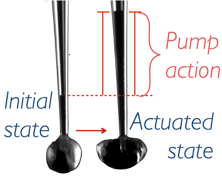Soft robotics
If you polymerize and lightly crosslink a nematic liquid crystal, in a uniformly aligned state, into a rubber, you make an amazing material called a liquid crystal elastomer (LCE). They have the extraordinary ability to contract along the nematic director and expand in the two perpendicular dimensions as a result of a phase transition from the nematic to the isotropic state. This transition can be induced by heating or, with appropriate additives, by light irradiation. The shape change can be up to several 100%, so an LCE can be a very useful artificial muscle. This is all the more so since it is soft: it is, after all, a rubber.

[1] One-piece micropumps from liquid crystalline core-shell particles Eva-Kristina Fleischmann, Hsin-Ling Liang, Nadia Kapernaum, Frank Giesselmann, Jan P.F. Lagerwall, and Rudolf Zentel Nat. Commun., 8, (2012), DOI: 10.1038/ncomms2193
Click here for a a 1-page popular science introduction to this paper.
 Back to research overview.
Back to research overview.
ERROR Global content file could not be located. Do you have your link setting set properly? (GC File:../../(null)/(null))






